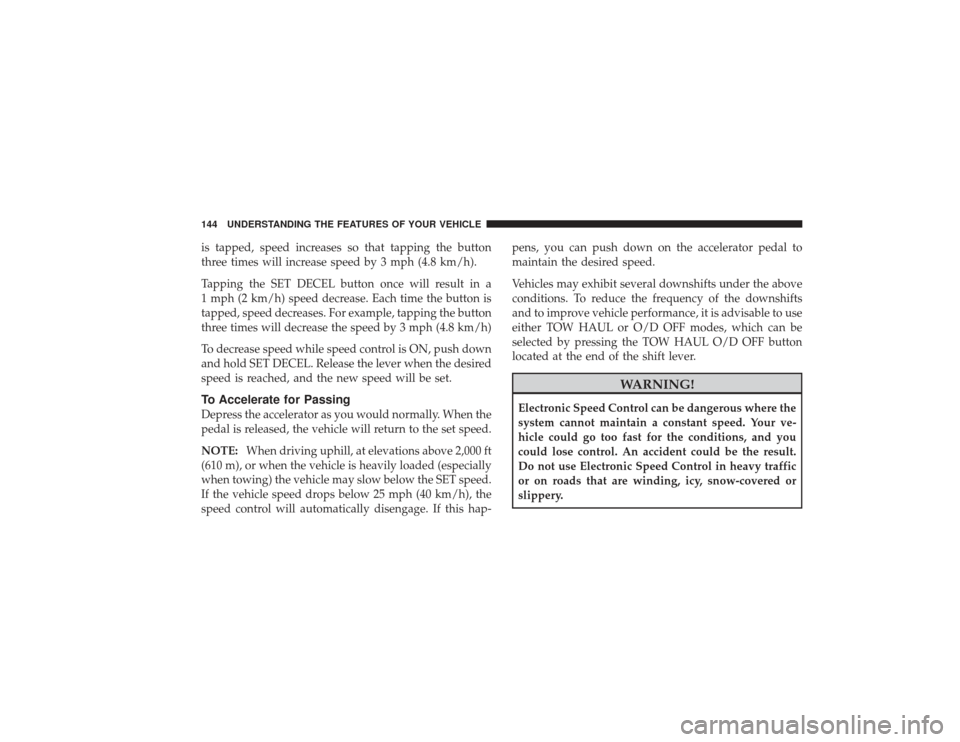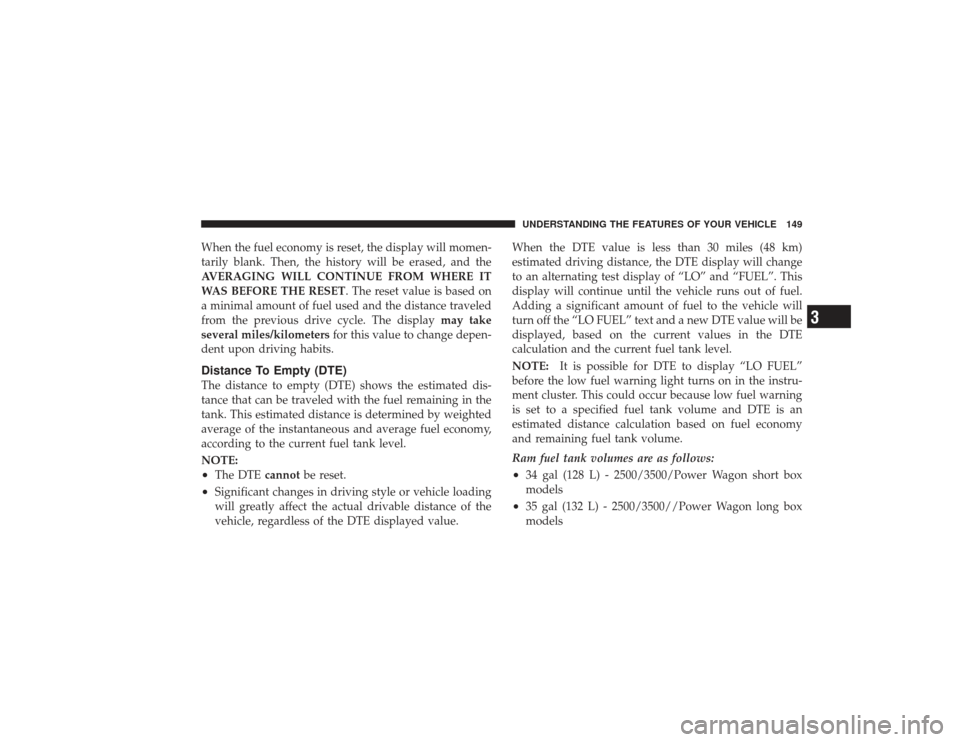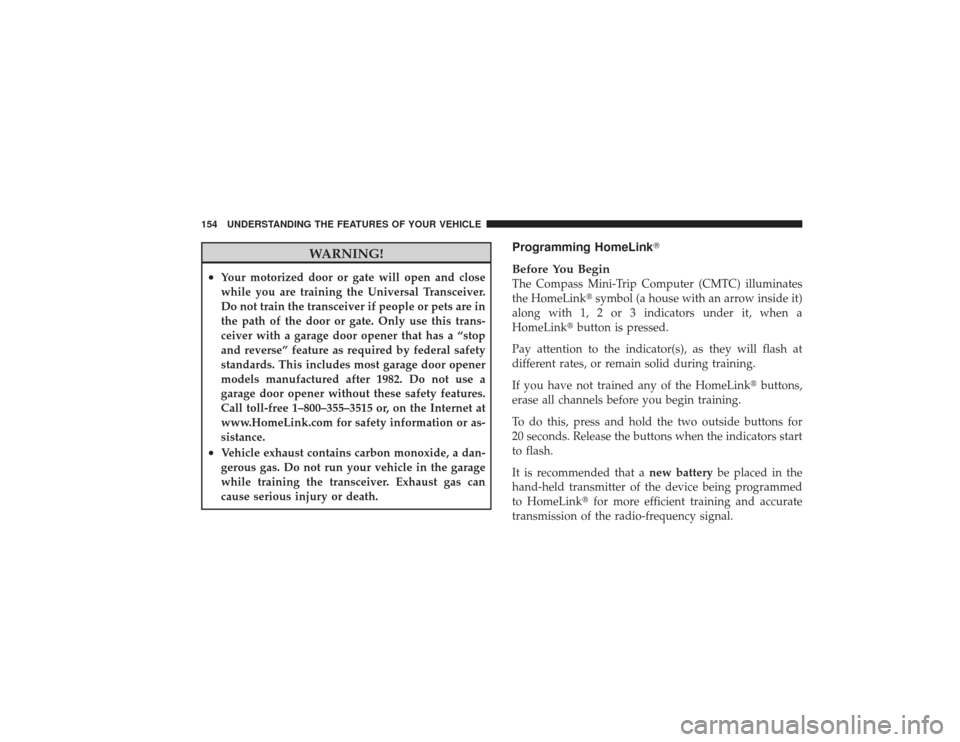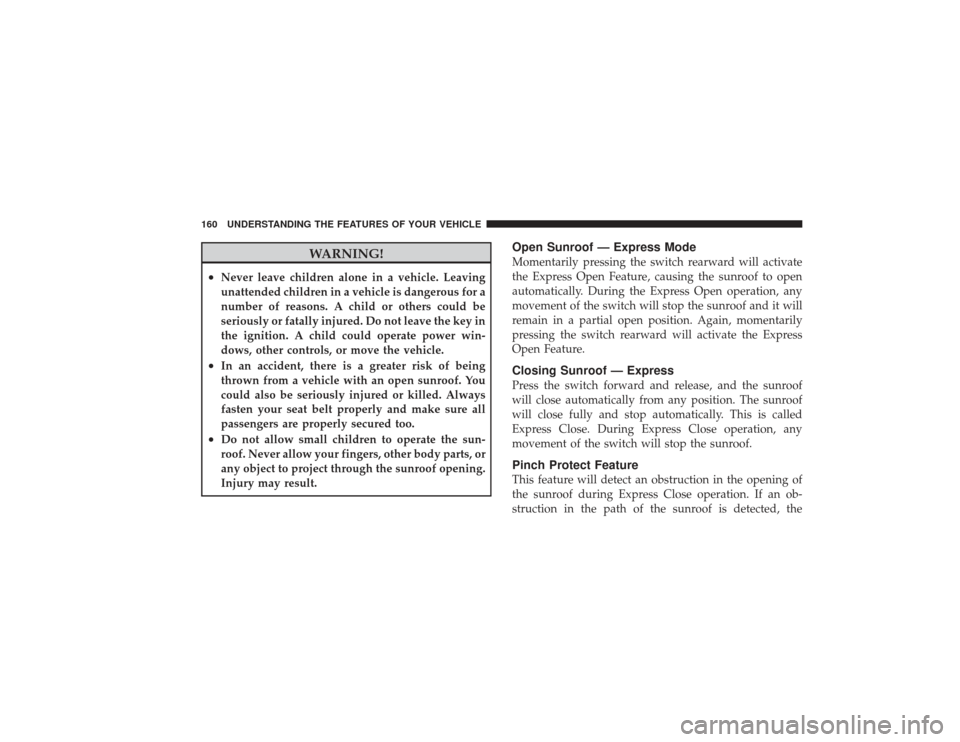Page 141 of 532
WARNING!
Sudden loss of visibility through the windshield
could lead to an accident. You might not see other
vehicles or other obstacles. To avoid sudden icing of
the windshield during freezing weather, warm the
windshield with the defroster before and during
windshield washer use.
Windshield WashersTo use the washer, push in on the washer knob on the end
of the multifunction lever and hold while spray is
desired. If the washer knob is depressed while in the
delay range, the wiper will operate for several seconds
after the washer knob is released. It will then resume the
intermittent interval previously selected. If the washer
knob is pushed for a period greater than one second
while in the off position, the wiper will cycle approxi-
mately three times after the wash knob is released.UNDERSTANDING THE FEATURES OF YOUR VEHICLE 139
3
Page 142 of 532
TILT STEERING COLUMNThis feature allows you to tilt the steering column
upward or downward. The tilt control lever is located on
the left-side of the steering column, just below the
multifunction lever.
Pull the lever toward the steering wheel to unlock the
steering column. Move the steering column up or down
as desired, and push the lever toward the instrument
panel to lock the column firmly in place.
WARNING!
Tilting the steering column while the vehicle is
moving is dangerous. Without a stable steering col-
umn, you could lose control of the vehicle and have
an accident. Adjust the column only while the ve-
hicle is stopped. Be sure it is locked before driving.
Tilt Steering Control Lever
140 UNDERSTANDING THE FEATURES OF YOUR VEHICLE
Page 145 of 532

simultaneously. If this occurs, the Electronic Speed Con-
trol System can be reactivated by pushing the Electronic
Speed Control ON/OFF button and resetting the desired
vehicle set speed.To ActivatePush the ON/OFF button to the ON position. In the
instrument cluster, the word “CRUISE” illuminates when
the system is on.To Set a Desired SpeedWhen the vehicle has reached the desired speed, press
and release the SET button. Release the accelerator and
the vehicle will operate at the selected speed.To DeactivateA soft tap on the brake pedal, normal braking, clutch
pressure while slowing the vehicle, or pressing the CAN-
CEL button will deactivate speed control without erasing
the memory. Pushing the ON/OFF button to the OFF
position or turning off the ignition erases the memory.
WARNING!
Leaving the Electronic Speed Control on when not in
use is dangerous. You could accidentally set the
system to cause it to go faster than you want. You
could lose control and have an accident. Always
leave the system off when you are not using it.To Resume SpeedTo resume a previously set speed, push and release the
RESUME button. Resume can be used at any speed above
20 mph (32 km/h).To Vary the Speed SettingWhen the speed control is on, speed can be increased by
pressing and holding the ACCEL button. When the
button is released, a new set speed will be established.
Tapping the RESUME ACCEL button once will result in a
speed increase of 1 mph (2 km/h). Each time the buttonUNDERSTANDING THE FEATURES OF YOUR VEHICLE 143
3
Page 146 of 532

is tapped, speed increases so that tapping the button
three times will increase speed by 3 mph (4.8 km/h).
Tapping the SET DECEL button once will result in a
1 mph (2 km/h) speed decrease. Each time the button is
tapped, speed decreases. For example, tapping the button
three times will decrease the speed by 3 mph (4.8 km/h)
To decrease speed while speed control is ON, push down
and hold SET DECEL. Release the lever when the desired
speed is reached, and the new speed will be set.To Accelerate for PassingDepress the accelerator as you would normally. When the
pedal is released, the vehicle will return to the set speed.
NOTE:When driving uphill, at elevations above 2,000 ft
(610 m), or when the vehicle is heavily loaded (especially
when towing) the vehicle may slow below the SET speed.
If the vehicle speed drops below 25 mph (40 km/h), the
speed control will automatically disengage. If this hap- pens, you can push down on the accelerator pedal to
maintain the desired speed.
Vehicles may exhibit several downshifts under the above
conditions. To reduce the frequency of the downshifts
and to improve vehicle performance, it is advisable to use
either TOW HAUL or O/D OFF modes, which can be
selected by pressing the TOW HAUL O/D OFF button
located at the end of the shift lever.
WARNING!
Electronic Speed Control can be dangerous where the
system cannot maintain a constant speed. Your ve-
hicle could go too fast for the conditions, and you
could lose control. An accident could be the result.
Do not use Electronic Speed Control in heavy traffic
or on roads that are winding, icy, snow-covered or
slippery.
144 UNDERSTANDING THE FEATURES OF YOUR VEHICLE
Page 151 of 532

When the fuel economy is reset, the display will momen-
tarily blank. Then, the history will be erased, and the
AVERAGING WILL CONTINUE FROM WHERE IT
WAS BEFORE THE RESET. The reset value is based on
a minimal amount of fuel used and the distance traveled
from the previous drive cycle. The displaymay take
several miles/kilometers for this value to change depen-
dent upon driving habits.Distance To Empty (DTE)The distance to empty (DTE) shows the estimated dis-
tance that can be traveled with the fuel remaining in the
tank. This estimated distance is determined by weighted
average of the instantaneous and average fuel economy,
according to the current fuel tank level.
NOTE:•
The DTE cannotbe reset.
•
Significant changes in driving style or vehicle loading
will greatly affect the actual drivable distance of the
vehicle, regardless of the DTE displayed value. When the DTE value is less than 30 miles (48 km)
estimated driving distance, the DTE display will change
to an alternating test display of “LO” and “FUEL”. This
display will continue until the vehicle runs out of fuel.
Adding a significant amount of fuel to the vehicle will
turn off the “LO FUEL” text and a new DTE value will be
displayed, based on the current values in the DTE
calculation and the current fuel tank level.
NOTE:
It is possible for DTE to display “LO FUEL”
before the low fuel warning light turns on in the instru-
ment cluster. This could occur because low fuel warning
is set to a specified fuel tank volume and DTE is an
estimated distance calculation based on fuel economy
and remaining fuel tank volume.
Ram fuel tank volumes are as follows:
•
34 gal (128 L) - 2500/3500/Power Wagon short box
models
•
35 gal (132 L) - 2500/3500//Power Wagon long box
modelsUNDERSTANDING THE FEATURES OF YOUR VEHICLE 149
3
Page 153 of 532

WARNING!
Even if the display still reads a few degrees above
32°F ( 0°C), the road surface may be icy, particularly
in woods or on bridges. Drive carefully under such
conditions to prevent an accident and possible per-
sonal injury or property damage.Automatic Compass CalibrationThis compass is self-calibrating which eliminates the
need to manually set the compass. When the vehicle is
new, the compass may appear erratic and the CAL
symbol will be displayed.
After completing up to three 360 degree turns, with the
vehicle traveling less than 5 mph (8 km/h), in an area free
from large metal or metallic objects, the CAL symbol will
turn off and the compass will function normally.
Manual Compass CalibrationNOTE:To ensure proper compass calibration, make
sure the compass variance is properly set before manu-
ally calibrating the compass.
If the compass appears erratic and the CAL symbol does
not appear, you must manually put the compass into the
“Calibration” mode.Recalibrating The CompassStart the engine and leave the transmission in the PARK
position then set the display to “Compass/Temperature.”
Press and hold the RESET button to change the display
between VAR (compass variance) and CAL (compass
calibration) modes. When the CAL symbol is displayed,
complete one 360 degree turn in an area free from large
metal objects or power lines. The CAL symbol will turn
off and the compass will function normally.UNDERSTANDING THE FEATURES OF YOUR VEHICLE 151
3
Page 156 of 532

WARNING!
•
Your motorized door or gate will open and close
while you are training the Universal Transceiver.
Do not train the transceiver if people or pets are in
the path of the door or gate. Only use this trans-
ceiver with a garage door opener that has a “stop
and reverse” feature as required by federal safety
standards. This includes most garage door opener
models manufactured after 1982. Do not use a
garage door opener without these safety features.
Call toll-free 1–800–355–3515 or, on the Internet at
www.HomeLink.com for safety information or as-
sistance.
•
Vehicle exhaust contains carbon monoxide, a dan-
gerous gas. Do not run your vehicle in the garage
while training the transceiver. Exhaust gas can
cause serious injury or death.
Programming HomeLink�
Before You BeginThe Compass Mini-Trip Computer (CMTC) illuminates
the HomeLink� symbol (a house with an arrow inside it)
along with 1, 2 or 3 indicators under it, when a
HomeLink� button is pressed.
Pay attention to the indicator(s), as they will flash at
different rates, or remain solid during training.
If you have not trained any of the HomeLink� buttons,
erase all channels before you begin training.
To do this, press and hold the two outside buttons for
20 seconds. Release the buttons when the indicators start
to flash.
It is recommended that a new batterybe placed in the
hand-held transmitter of the device being programmed
to HomeLink� for more efficient training and accurate
transmission of the radio-frequency signal.
154 UNDERSTANDING THE FEATURES OF YOUR VEHICLE
Page 162 of 532

WARNING!
•
Never leave children alone in a vehicle. Leaving
unattended children in a vehicle is dangerous for a
number of reasons. A child or others could be
seriously or fatally injured. Do not leave the key in
the ignition. A child could operate power win-
dows, other controls, or move the vehicle.
•
In an accident, there is a greater risk of being
thrown from a vehicle with an open sunroof. You
could also be seriously injured or killed. Always
fasten your seat belt properly and make sure all
passengers are properly secured too.
•
Do not allow small children to operate the sun-
roof. Never allow your fingers, other body parts, or
any object to project through the sunroof opening.
Injury may result.
Open Sunroof — Express ModeMomentarily pressing the switch rearward will activate
the Express Open Feature, causing the sunroof to open
automatically. During the Express Open operation, any
movement of the switch will stop the sunroof and it will
remain in a partial open position. Again, momentarily
pressing the switch rearward will activate the Express
Open Feature.Closing Sunroof — ExpressPress the switch forward and release, and the sunroof
will close automatically from any position. The sunroof
will close fully and stop automatically. This is called
Express Close. During Express Close operation, any
movement of the switch will stop the sunroof.Pinch Protect FeatureThis feature will detect an obstruction in the opening of
the sunroof during Express Close operation. If an ob-
struction in the path of the sunroof is detected, the
160 UNDERSTANDING THE FEATURES OF YOUR VEHICLE